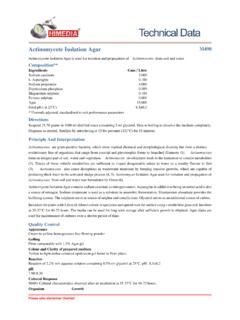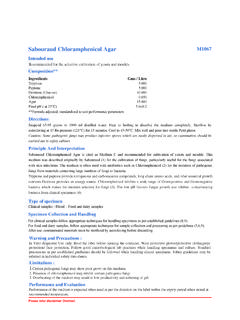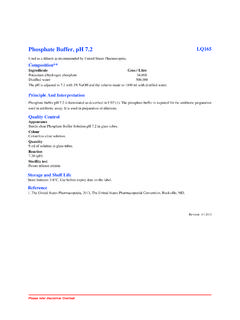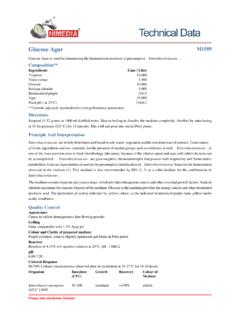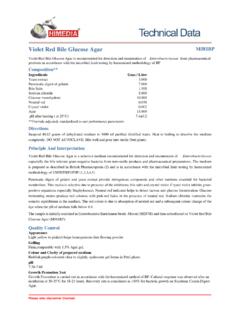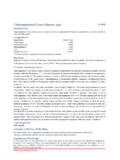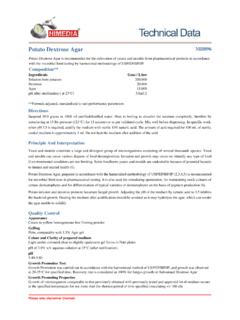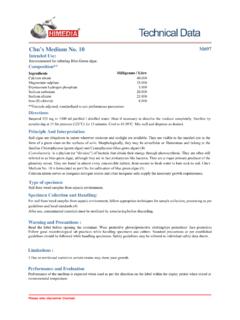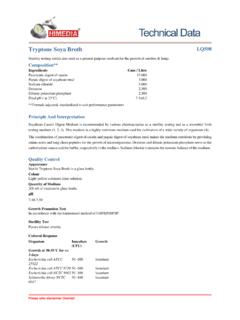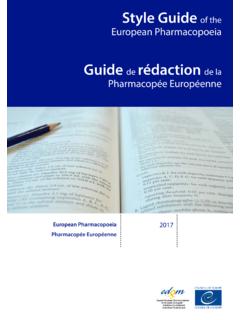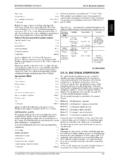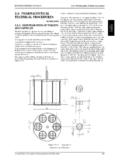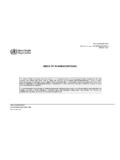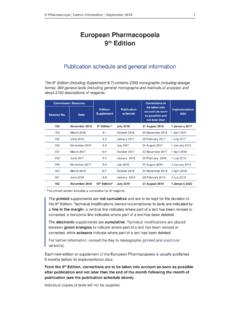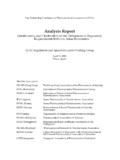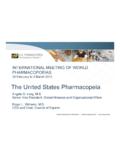Transcription of Enterobacteria Enrichment Broth, Mossel MH - HiMedia Labs
1 Please refer disclaimer Enrichment broth , MosselMH287 Intended useEnterobacteria Enrichment broth , Mossel is used for selective Enrichment of Enterobacteriaceae from pharmaceutical products in accordance with the microbial limit testing by harmonized methodology of USP/EP/BP/JP/IP . Composition**IngredientsGms / LitreGelatin peptone # bile ## hydrogen phosphate, dihydrate dihydrogen pH after heating ( at 25 C) # Pancreatic digest of gelatin## Dehydrated ox-bile**Formula adjusted, standardized to suit performance parametersDirectionsSuspend grams (the equivalent weight of dehydrated medium per litre)in 1000 ml purified/distilled water. Dispense into tubes or flasks as desired. Heat in free flowing steam or boiling water (100 C) for 30 minutes and cool immediately.
2 DO NOT And InterpretationThe family Enterobacteriaceae consists of Salmonella, Shigella and other enteric pathogens. These organisms find entry into the food system through faecally contaminated water. Majority of these organisms may be eliminated under the stringent food processing parameters. But some of these organisms may become sub lethally injured during the changes in pH, exposure to steam or heat and other unfavourable conditions (1). Therefore the important aspect of food monitoring depends upon the identification and enumeration of these injured cells, after resuscitation. EE broth , Mossel , formulated by Mossel et al (2) is recommended as an Enrichment medium for bile tolerant gram-negative bacteria in the biological examination of foods (2), animal feed stuffs (3).
3 This medium is prepared in accordance with the harmonized method of USP/EP/BP/JP/IP(4,5,6,7,11).Gelatin peptone and glucose monohydrate allows the growth of most of the members of Enterobacteriaceae. Brilliant green and dehydrated bile are the inhibitory agents for gram-positive bacteria. Phosphates act as a good buffering agent and neutralizes acids produced by lactose fermenters that otherwise would adversely affect the growth of the organism. Lactose negative, anaerogenic lactose-positive or late lactose fermenting Enterobacteriaceae are often missed by the standard Coli-aerogenes test. To overcome this problem, lactose is replaced by glucose in this medium. Phosphates form the buffering system of the medium.
4 The cells damaged while drying or low pH are resuscitated in well-aerated Soybean Casein Digest broth (MH011) for 2 hours at 25 C prior to Enrichment in EE broth . The resuscitation procedure is recommended for dried foods (8), animal feeds (9) and semi-preserved foods (10). EE broth is an Enrichment broth and should be used in conjunction with Violet Red Bile Glucose Agar (MH581). A loopful of the enriched sample from EE broth . is subcultured onto Violet Red Bile Glucose Agar (MH581) after an initial incubation at 30-35 C for 24 hours. Typical pink colonies from MH581 are subcultured for biochemical confirmation by oxidase and fermentation reactions (4). Decimal dilutions of the food homogenate are used if the expected counts are high or else initial suspension is used.
5 EE broth , Mossel (MH287)Type of specimen Pharmaceutical samplesHiMedia LaboratoriesTechnical DataPlease refer disclaimer Promotion TestGrowth Promotion is carried out in accordance with the harmonized method of USP/EP/BP/JP/IP. Cultural response was observed after an incubation at 30-35 C for specified promoting propertiesClearly visible growth of microorganism comparable to that previously obtained with previously tested and approved lot ofmedium occurs at the specified temperature for not more than the shortest period of time specified inoculating <=100 cfu (at30-35 C for <=24 hours).Inhibitory propertiesNo growth of the test microorganism occurs for the specified temp for not less than longest period of time specifiedinoculating >= 100cfu (at 30-35 C for >= 48 hours).
6 Cultural ResponseMH287: Cultural characteristics observed after incubation at 30-35 C for 24-48 (CFU)GrowthAcidIncubationtemperatureIncu bationperiodGrowth PromotingEscherichia coli ATCC 8739 (00012*)50 -100luxuriantpositivereaction, yellowcolour30 -35 C<=24 hrsPseudomonas aeruginosa ATCC 9027 (00026*))50 -100luxuriant-30 -35 C<=24 hrsInhibitoryStaphylococcus aureus ATCC 6538 (00032*)>=10 inhibited30 -35 C>=48 hrsAdditional MicrobiologicaltestingEscherichia coli ATCC25922 (00013*)50 -100luxuriantpositivereaction, yellowcolour30 -35 C24 -48 hrsQuality ControlAppearanceLight yellow to greenish yellow homogeneous free flowing powderColour and Clarity of prepared mediumEmerald green coloured, clear solution without any precipitateSpecimen Collection and HandlingFor pharmaceutical samples, follow appropriate techniques for sample collection, processing as per guidelines (2,3,4,5,7).
7 After use, contaminated materials must be sterilized by autoclaving before and Precautions:Read the label before opening the container. Wear protective gloves/protective clothing/eye protection/face protection. Follow good microbiological lab practices while handling specimens and culture. Standard precautions as per established guidelines should be followed while handling specimens. Safety guidelines may be referred in individual safety data isolation has to be carried out for and EvaluationPerformace of the medium is expected when used as per the direction on the label within the expiry period when stored at recommended LaboratoriesTechnical United States pharmacopoeia , 2018, The United States Pharmacopeial Convention.
8 Rockville, MD. pharmacopoeia , 2018, The Stationery office British pharmacopoeia , 2018, European Dept. for the quality of pharmacopoeia , and Ratto , 1970, Appl. Microbiol., 20 and Shennan and Clare V., 1973, J. Sci. Fd. Agric., 24 : , Ratto , 1973, J. Fd. Technol., 8 : Indian pharmacopoeia 2017, Govt. of India, 2017. The Controller of Publication, : 04 / 2018 D. A. A., and Harrewijn G. A., 1972, Alimenta II, D. A. A., Vissar M. and Cornellisen A. M. R., 1963, J. , 26(3) Schothurst M. et al, 1966, Vet Med., 13(3) mirabilis ATCC2593350 -100luxuriantpositivereaction, yellowcolour30 -35 C24 -48 hrsSalmonella Enteritidis ATCC13076 ( 00030*)50 -100luxuriantpositivereaction, yellowcolour30 -35 C24 -48 hrsShigella boydii ATCC 1203050 -100luxuriantnegativereaction30 -35 C24 -48 hrsStaphylococcus aureus subsp.
9 Aureus ATCC 25923 (00034*)>=10 inhibited30 -35 C>=48 hrsEnterobacter aerogenes ATCC 13048 (00175*)50 -100luxuriantpositivereaction, yellowcolour30 -35 C24 -48 hrsPseudomonas aeruginosa ATCC 27853 (00025*)50 -100luxuriant-30 -35 C24 -48 hrsEscherichia coli NCTC 900250 -100luxuriantpositivereaction, yellowcolour30 -35 C24 -48 hrsKey : *Corresponding WDCM and Shelf LifeStore below 30 C in a tightly closed container and the prepared medium at 2 - 8 C. Use before expiry date on the label. Onopening, product should be properly stored dry, after tightly capping the bottle in order to prevent lump formation due to thehygroscopic nature of the product. Improper storage of the product may lead to lump formation. Store in dry ventilated areaprotected from extremes of temperature and sources of ignition Seal the container tightly after use.
10 Use before expiry date onthe label. Product performance is best if used within stated expiry must ensure safe disposal by autoclaving and/or incineration of used or unusable preparations of this product. Follow established laboratory procedures in disposing of infectious materials and material that comes into contact with sample must be decontaminated and disposed of in accordance with current laboratory techniques (8,9).Murray P. R, Baron E, J., Jorgensen J. H., Pfaller M. A., Yolken R. H., (Eds.), 8th Ed., 2003, Manual of Clinical Microbiology, , Clinical Microbiology Procedures Handbook. 2nd EditionDisclaimer :User must ensure suitability of the product(s) in their application prior to use. Products conform solely to the information contained inthis and other related HiMedia publications.
